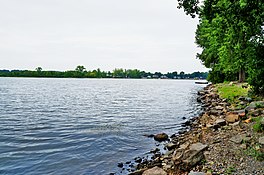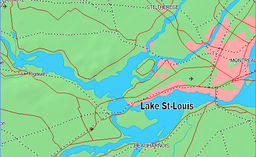|
Lake Saint-Louis
Lake Saint-Louis is a lake in southwestern Quebec, Canada, at the confluence of the Saint Lawrence and Ottawa rivers. The Saint Lawrence Seaway passes through the lake. Lake St. Louis is a widening of the St. Lawrence River in the Hochelaga Archipelago. It is also fed by the Ottawa River via the Lake of Two Mountains at Sainte-Anne-de-Bellevue, the Beauharnois Canal, the Soulanges Canal, the Saint-Louis River, and the Châteauguay River. The lake is bounded to the north and the east by the Island of Montreal, by Beauharnois-Salaberry, Roussillon, and Vaudreuil-Soulanges. The town of Beauharnois with its power-dam and canal lie to the south. The West Island shore is mostly built up with private houses, but it includes some parks and clubs such as the Pointe-Claire Canoe Club, and the Pointe-Claire Yacht Club. Islands in the lake include Dorval and Dowker Islands. Lake St. Louis is the second of three fluvial lakes on the St. Lawrence River; upstream of it is Lake Saint Francis, and downstream is Lake Saint Pierre. Lake St. Louis has an average flow of 8,400 cubic metres per second (300,000 cu ft/s).[1] The lake has many species of fish, including yellow perch. A small map by Samuel Champlain of 1611 names the lake. The same year, Champlain reported that a young man named Louys was drowned in what is now known as the Lachine Rapids, and in 1870 Charles-Honoré Laverdière stated that the rapids, and later the lake, were named in honour of the drowned man. A 1656 Jesuit account describes a crossing «Lac Saint Louys».[2] In 2014 there was a report of fecal coliform flowing into the lake from a Beaconsfield creek,[3] and of PCBs flowing into it from a Pointe-Claire industrial site.[4] References
|
||||||||||||||||||||||||||||
Portal di Ensiklopedia Dunia


